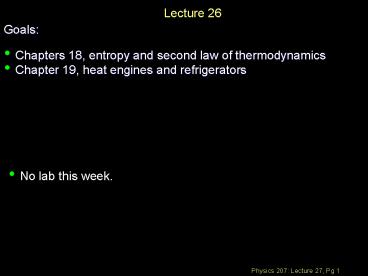Goals: - PowerPoint PPT Presentation
1 / 21
Title:
Goals:
Description:
Heat engine is a general term for a device that takes heat from a hot system and converts part of that heat into work. Humans have been using heat to stay warm for ... – PowerPoint PPT presentation
Number of Views:35
Avg rating:3.0/5.0
Title: Goals:
1
Lecture 26
- Goals
- Chapters 18, entropy and second law of
thermodynamics - Chapter 19, heat engines and refrigerators
- No lab this week.
2
Equipartition theorem
- Things are more complicated when energy can be
stored in other degrees of freedom of the system.
monatomic gas translation solids
translationpotential energy diatomic molecules
translationvibrationsrotations
3
Equipartition theorem
- The thermal energy is equally divided among all
possible energy modes (degrees of freedom). The
average thermal energy is (1/2)kBT for each
degree of freedom.
eavg(3/2) kBT (monatomic gas) eavg(6/2) kBT
(solids) eavg(5/2) kBT (diatomic molecules)
- Note that if we have N particles
Eth(3/2)N kBT (3/2)nRT (monatomic
gas) Eth(6/2)N kBT (6/2)nRT (solids) Eth(5/2)N
kBT (5/2)nRT (diatomic molecules)
4
Specific heat
- Molar specific heats can be directly inferred
from the thermal energy.
Eth(6/2)N kBT (6/2)nRT (solid) ?Eth(6/2)nR?TnC
?T C3R (solid)
- The specific heat for a diatomic gas will be
larger than the specific heat of a monatomic gas
CdiatomicCmonatomicR
5
Second Law and Entropy
- A perfume bottle breaks in the corner of a room.
After some time, what would you expect?
B)
A)
6
very unlikely
- The probability for each particle to be on the
left half is ½.
probability(1/2)N
7
Second Law of thermodynamics
- The entropy of an isolated system never
decreases. It can only increase, or in
equilibrium, remain constant. - The laws of probability dictate that a system
will evolve towards the most probable and most
random macroscopic state - Thermal energy is spontaneously transferred from
a hotter system to a colder system.
8
Reversible vs Irreversible
- The following conditions should be met to make a
process perfectly reversible - 1. Any mechanical interactions taking place in
the process should be frictionless. - 2. Any thermal interactions taking place in the
process should occur across infinitesimal
temperature or pressure gradients (i.e. the
system should always be close to equilibrium.)
9
Reversible vs Irreversible
- Based on the above comments, which of the
following processes is not reversible? - A. Lowering a frictionless piston in a cylinder
by placing a bag of sand on top of the piston. - B. Lifting the piston described in the previous
statement by removing one tiny grain of sand at a
time.
10
Heat Engines
- Turning heat into work Industrial revolution.
11
Key concepts
- Work done by the system
Wsystem-Wexternal
- Energy reservoir An object that interacts with
the system that is sufficiently large such that
its temperature is almost constant.
QH The amount of heat transferred to/from hot
reservoir QC The amount of heat transferred
to/from cold reservoir
12
Energy-transfer diagram
Hot reservoir
QH
cyclic system ?Esystem0
WoutQH-QC
Wout
QC
Cold reservoir
13
Thermal efficiency
For practical reasons, we would like an engine to
do the maximum amount of work with the minimum
amount of fuel. We can measure the performance of
a heat engine in terms of its thermal efficiency
? (lowercase Greek eta), defined as
We can also write the thermal efficiency as
14
- What is the largest thermal efficiency that a
heat engine can have?
C) ?1/2
A) ?2
B) ?1
D) ?0
15
Refrigerators
- Devices that uses work to transfer heat from a
colder object to a hotter object.
Hot reservoir
QH
WinQCQH
Win
KQC/Win
QC
Cold reservoir
16
Is perfect engine possible?
Hot reservoir
QH1
QH2
QH
Wout
Win
QC
QC
Cold reservoir
17
Turbines Brayton Cycle
18
- Which of the following processes would have the
largest work output per cycle?
A)
B)
C)
P
P
P
V
V
V
19
Internal combustion engine gasoline engine
- A gasoline engine utilizes the Otto cycle, in
which fuel and air are mixed before entering the
combustion chamber and are then ignited by a
spark plug.
Otto Cycle
(Adiabats)
20
The best thermal engine ever, the Carnot engine
- A perfectly reversible engine (a Carnot engine)
can be operated either as a heat engine or a
refrigerator between the same two energy
reservoirs, by reversing the cycle and with no
other changes.
21
The Carnot Engine
- Carnot showed that the thermal efficiency of a
Carnot engine is
- All real engines are less efficient than the
Carnot engine because they operate irreversibly
due to the path and friction as they complete a
cycle in a brief time period.

